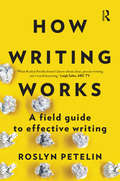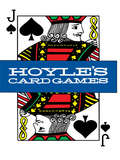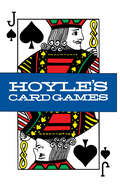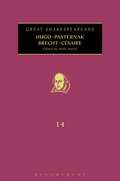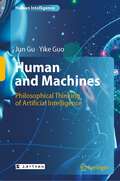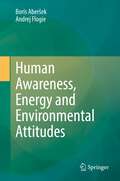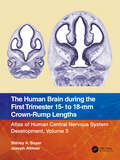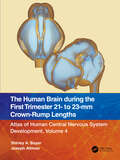- Table View
- List View
How Writing Works: A field guide to effective writing
by Roslyn PetelinThis is Roslyn Petelin's promise: whether you already write reasonably well or not, this book will exponentially improve your writing.How Writing Works is a lively and practical introduction to the elements of grammar, sentence structure, and style that you need to write well. The book covers social media and writing for online publication, as well as the most common documents in the university and the writing-reliant workplace.How Writing Works should be on the desk of everyone who needs to write: students, professionals in all fields, and creative writers.'A superb guide to great writing in the modern media era.' Phil Harding, journalist and broadcaster, London'Whether you're a CEO or an intern, the ability to communicate clearly is your biggest asset. Petelin's expert advice in this book will accelerate your career'. Damian Kington, Global Head of Marketing, Liquidnet, New York
How Writing Works: A field guide to effective writing
by Roslyn PetelinThis is Roslyn Petelin's promise: whether you already write reasonably well or not, this book will exponentially improve your writing.How Writing Works is a lively and practical introduction to the elements of grammar, sentence structure, and style that you need to write well. The book covers social media and writing for online publication, as well as the most common documents in the university and the writing-reliant workplace.How Writing Works should be on the desk of everyone who needs to write: students, professionals in all fields, and creative writers.'A superb guide to great writing in the modern media era.' Phil Harding, journalist and broadcaster, London'Whether you're a CEO or an intern, the ability to communicate clearly is your biggest asset. Petelin's expert advice in this book will accelerate your career'. Damian Kington, Global Head of Marketing, Liquidnet, New York
How your car works: Your guide to the components & systems of modern cars, including hybrid & electric vehicles
by Arvid LindeA comprehensive guided tour under the skin of the car. Diesel, petrol (gasoline), electric, hybrid and alternative propulsions are all dissected and explained in a reader-friendly manner, and as you move from the engine to the tailpipe, you'll discover what an exciting world there is within the car. Organised in intuitive chapters and backed with colourful illustrations and cutaways, this book describes the systems and parts that make your car move. Without emphasising the 'boring' science bits, it discusses the practical application of various automotive terms, and explains why having more of one thing and less of another is beneficial in the real world. Whether you're just curious, or wish to become a better car owner, this book will start you on an exciting journey.
How your motorcycle works: Your guide to the components & systems of modern motorcycles (RAC Handbook)
by Peter HenshawNo longer the simple machines they used to be, the modern motorcycle is as complex and diverse as the modern car. In an ever more competitive market, manufacturers are looking for new solutions to old problems - what's the most efficient transmission? How can emissions and fuel consumption be cut without affecting power? And how can new models be differentiated from one another?This book explains how the modern motorcycle works, in a straightforward style that's jargon-free and easy to read. It assumes no prior mechanical knowledge, simply an interest in a motorcycle's workings, and an open mind. The text is accompanied by superb cutaway illustrations from the major motorcycle manufacturers, clearly showing how individual components and systems function. It covers the latest innovations, including traction control and pushbutton gear change, as well as long-established technologies, such as fuel injection and ABS.How your motorcycle works will not transform you into a motorcycle engineer or expert mechanic, but in explaining precisely how everything works, it will increase your understanding, and thus enjoyment, of the machine.
Hoyles Card Games
by L. DawsonFirst published in 1979. Routledge is an imprint of Taylor & Francis, an informa company.
Hoyles Card Games
by Lawrence H. DawsonFirst published in 1979. Routledge is an imprint of Taylor & Francis, an informa company.
Hugh Johnson Pocket Wine 2021: New Edition
by Hugh JohnsonThe world's best-selling annual wine guide.Hugh Johnson's Pocket Wine Book is the essential reference book for everyone who buys wine - in shops, restaurants, or on the internet. Now in its 44th year of publication, it has no rival as the comprehensive, up-to-the-minute annual guide. Hugh Johnson provides clear succinct facts and commentary on the wines, growers and wine regions of the whole world. He reveals which vintages to buy, which to drink and which to cellar, which growers to look for and why. Hugh Johnson's Pocket Wine Book gives clear information on grape varieties, local specialities and how to match food with wines that will bring out the best in both.This latest edition of Hugh Johnson's Pocket Wine Book includes a colour supplement on terroir.
Hugh Johnson Pocket Wine 2022: The new edition of the no 1 best-selling wine guide
by Hugh Johnson Margaret RandThe world's best-selling annual wine guide.Hugh Johnson's Pocket Wine Book is the essential reference book for everyone who buys wine - in shops, restaurants, or on the internet. Now in its 45th year of publication, it has no rival as the comprehensive, up-to-the-minute annual guide. It provides clear succinct facts and commentary on the wines, growers and wine regions of the whole world. It reveals which vintages to buy, which to drink and which to cellar, which growers to look for and why. Hugh Johnson's Pocket Wine Book gives clear information on grape varieties, local specialities and how to match food with wines that will bring out the best in both.This latest edition of Hugh Johnson's Pocket Wine Book includes a colour supplement: The Ten Best Things About Wine Right Now.
Hugh Johnson Pocket Wine 2024
by Hugh Johnson Margaret RandThe world's best-selling annual wine guide.Hugh Johnson's Pocket Wine Book is the essential reference book for everyone who buys wine - in shops, restaurants, or on the internet. Now in its 47th year of publication, it has no rival as the comprehensive, up-to-the-minute annual guide.It provides clear succinct facts and commentary on the wines, growers and wine regions of the whole world. It reveals which vintages to buy, which to drink and which to cellar, which growers to look for and why. Hugh Johnson's Pocket Wine 2024 gives clear information on grape varieties, local specialities and how to match food with wines that will bring out the best in both.This latest edition of Hugh Johnson's Pocket Wine 2024 includes a colour supplement on Chardonnay, the world's most obliging grape, discussing everything from history and taste to texture, fashion and the role oak plays.
Hugh Johnson's Pocket Wine 2020: The new edition of the no 1 best-selling wine guide
by Hugh JohnsonHugh Johnson's Pocket Wine Book is the essential reference book for everyone who buys wine - in shops, restaurants, or on the internet. Now in its 43rd year of publication, it has no rival as the comprehensive, up-to-the-minute annual guide. Hugh Johnson provides clear succinct facts and commentary on the wines, growers and wine regions of the whole world. He reveals which vintages to buy, which to drink and which to cellar, which growers to look for and why. Hugh Johnson's Pocket Wine Book gives clear information on grape varieties, local specialities and how to match food with wines that will bring out the best in both.This latest edition of Hugh Johnson's Pocket Wine Book includes a colour supplement on 'Wine Flavour: How, What, Why?'
Hugh Johnson's Pocket Wine Book 2018
by Hugh JohnsonHugh Johnson's Pocket Wine Book is the essential reference book for everyone who buys wine - in shops, restaurants, or on the internet. Now in its 41st year of publication, it has no rival as the comprehensive, up-to-the-minute annual guide. Hugh Johnson provides clear succinct facts and commentary on the wines, growers and wine regions of the whole world. He reveals which vintages to buy, which to drink and which to cellar, which growers to look for and why. Hugh Johnson's Pocket Wine Book gives clear information on grape varieties, local specialities and how to match food with wines that will bring out the best in both. This new edition also contains a colour supplement on Syrah and Garnacha grapes.
Hugh Johnson's Pocket Wine Book 2019
by Hugh JohnsonHugh Johnson's Pocket Wine Book is the essential reference book for everyone who buys wine - in shops, restaurants, or on the internet. Now in its 42nd year of publication, it has no rival as the comprehensive, up-to-the-minute annual guide. Hugh Johnson provides clear succinct facts and commentary on the wines, growers and wine regions of the whole world. He reveals which vintages to buy, which to drink and which to cellar, which growers to look for and why. Hugh Johnson's Pocket Wine Book gives clear information on grape varieties, local specialities and how to match food with wines that will bring out the best in both. This new edition also contains a special supplement on Organic, Natural and Biodynamic wines.
Hugh Johnson's Pocket Wine Book 2023
by Hugh Johnson Margaret RandThe world's best-selling annual wine guide.Hugh Johnson's Pocket Wine Book is the essential reference book for everyone who buys wine - in shops, restaurants, or on the internet. Now in its 46th year of publication, it has no rival as the comprehensive, up-to-the-minute annual guide.This latest edition of Hugh Johnson's Pocket Wine Book includes a color supplement: How Wine Ages (And Why), which covers questions such as whether aged wine is necessarily better wine and how to store wine to ensure it ages well. It provides clear succinct facts and commentary on the wines, growers and wine regions of the whole world. It reveals which vintages to buy, which to drink and which to cellar, which growers to look for and why. Hugh Johnson's Pocket Wine Book gives clear information on grape varieties, local specialities and how to match food with wines that will bring out the best in both.
Hugh Johnson's Pocket Wine Book 2025: The No1 Bestselling Guide
by Hugh Johnson Margaret Rand'A thorough guide to just about everything worth drinking.' The Times'Space for only one wine book in your life? This is it.' Howard G. Goldberg, The New York TimesTHE WORLD'S BESTSELLING ANNUAL WINE GUIDE Hugh Johnson's Pocket Wine Book is the essential reference book for everyone who buys wine - in shops, restaurants, or on the internet. Now in its 48th year of publication, it has no rival as the comprehensive, up-to-the-minute annual guide to wine.Providing clear succinct facts and commentary on the wines, growers and wine regions of the whole world, the book also reveals which vintages to buy, which to drink and which to cellar, as well as the best growers to look for and why. Hugh Johnson's Pocket Wine Book 2025 gives clear information on grape varieties, local specialities and how to match food with wines that will bring out the best in both.This latest edition of Hugh Johnson's Pocket Wine Book includes a colour supplement on Pinot Noir, the world's most highly prized grape, discussing everything from variety and food pairings, to Pinot Noir sparkling wines and how climate change has affected the production of this grape.
Hugo, Pasternak, Brecht, Césaire: Great Shakespeareans: Volume XIV (Great Shakespeareans)
by Ruth MorseGreat Shakespeareans offers a systematic account of those figures who have had the greatest influence on the interpretation, understanding and cultural reception of Shakespeare, both nationally and internationally.In this volume, leading scholars assess the contribution of Victor-Marie Hugo, François-Victor Hugo, Boris Leonidivich Pasternak, Bertolt Brecht and Aimé Césaire to the afterlife and reception of Shakespeare and his plays. Each substantial contribution assesses the double impact of Shakespeare on the figure covered and of the figure on the understanding, interpretation and appreciation of Shakespeare, provide a sketch of their subject's intellectual and professional biography and an account of the wider cultural context, including comparison with other figures or works within the same field.
Hugo, Pasternak, Brecht, Césaire: Great Shakespeareans: Volume XIV (Great Shakespeareans)
by Ruth MorseGreat Shakespeareans offers a systematic account of those figures who have had the greatest influence on the interpretation, understanding and cultural reception of Shakespeare, both nationally and internationally.In this volume, leading scholars assess the contribution of Victor-Marie Hugo, François-Victor Hugo, Boris Leonidivich Pasternak, Bertolt Brecht and Aimé Césaire to the afterlife and reception of Shakespeare and his plays. Each substantial contribution assesses the double impact of Shakespeare on the figure covered and of the figure on the understanding, interpretation and appreciation of Shakespeare, provide a sketch of their subject's intellectual and professional biography and an account of the wider cultural context, including comparison with other figures or works within the same field.
Human and Machines: Philosophical Thinking of Artificial Intelligence (Human Intelligence)
by Jun Gu Yike GuoThis book shares Chinese scholars’ philosophical views on artificial intelligence. The discussions range from the foundations of AI—the Turing test and creation of machine intelligence—to recent applications of AI, including decisions in games, natural languages, pattern recognition, prediction in economic contexts, autonomous behaviors, and collaborative intelligence, with the examples of AlphaGo, Microsoft’s Xiao Bing, medical robots, etc. The book’s closing chapter focuses on Chinese machines and explores questions on the cultural background of artificial intelligence. Given its scope, the book offers a valuable resource for all members of the general public who are interested in the future development of artificial intelligence, especially from the perspective of respected Chinese scholars.
The human atlas of Europe: A continent united in diversity
by Dimitris Ballas Danny DorlingWhat does Brexit actually mean for the UK and what are the wider implications for Europe? Was the UK ‘leave’ vote actually symptomatic of broader issues within Europe such as population mobility and the rise of non-traditional parties? Written by leading international authors, this timely atlas explores Europe’s society, culture, economy, politics and environment using state of the art mapping techniques With maps covering over 80 topics ranging from life expectancy, greenhouse gas emissions, GDP to Eurovision voting, The Human Atlas of Europe addresses fundamental questions around social cohesion and sustainable growth as Europe negotiates the UK’s exit while continuing through the economic crisis. This concise, accessible atlas is packed with exciting features, including: • short introductions to each topic • maps using the very latest data • infographics bringing this all to life • summaries of key information including league tables • core statistics on Europe Taken as a whole, the atlas shows how geographical and state boundaries only tell a partial story and that we still live in a far more cohesive Europe than we realise.
Human Awareness, Energy and Environmental Attitudes
by Boris Aberšek Andrej FlogieThis book raises awareness about environmental issues that result from energy production, extraction and conversion, and examines the attitudes people have about these issues. It discusses societal and educational relations associated with energy and environmental issues, focusing on philosophical, sociological and psychological views, and provides an analysis of how the individual and the society perceive, process and analyze the information on this subject. The authors present the concept of environmentally conscious engineering, discussing various forms of energy extraction and production, and detail alternative, under-researched and unaffordable solutions, such as nuclear fusion and artificial photosynthesis. The book also touches on topics such as the storage of energy and greenhouse gases, recycling and reuse of energy waste, and energy saving and efficiency. The book will be of interest to students and researchers of environmentally conscious engineering, energy use, and human dimensions of ecology and the environment, as well as NGOs, policy makers, and environmental activists.
Human Behavior and Public Policy: A Political Psychology
by Marshall H. SegallHuman Behavior and Public Policy: A Political Psychology examines knowledge about human behavior and its application to public policy analysis. It shows that the findings of psychological research provide information on how to better understand social problems and formulate and implement policies for the solution of such problems. Organized into nine chapters, the book first discusses how psychology can be used to shape society into a better home and then presents three models for political psychology. The next chapters deal with intellectual capacities, educability, and prejudice and discrimination in different groups of people. The book also explores violence and intergroup conflict resolutions and concludes with a proposal for a research design that serves as an example of political-psychological planning. Academic psychologists who teach interdisciplinary social sciences and courses concerned with public affairs will find this book invaluable.
Human Being @ Risk: Enhancement, Technology, and the Evaluation of Vulnerability Transformations (Philosophy of Engineering and Technology #12)
by Mark CoeckelberghWhereas standard approaches to risk and vulnerability presuppose a strict separation between humans and their world, this book develops an existential-phenomenological approach according to which we are always already beings-at-risk. Moreover, it is argued that in our struggle against vulnerability, we create new vulnerabilities and thereby transform ourselves as much as we transform the world. Responding to the discussion about human enhancement and information technologies, the book then shows that this dynamic-relational approach has important implications for the evaluation of new technologies and their risks. It calls for a normative anthropology of vulnerability that does not ask which objective risks are acceptable, how we can become invulnerable, or which technologies threaten human nature, but which vulnerability transformations we want. To the extent that we can steer the growth of new technologies at all, this tragic and sometimes comic project should therefore be guided by what we want to become.
The Human Brain during the First Trimester 15- to 18-mm Crown-Rump Lengths: Atlas of Human Central Nervous System Development, Volume 3
by Shirley A. Bayer Joseph AltmanThis third of 15 short atlases reimagines the classic 5-volume Atlas of Human Central Nervous System Development. This volume presents serial sections from specimens between 15 mm and 18 mm with detailed annotations, together with 3D reconstructions. An introduction summarizes human CNS development by using high-resolution photos of methacrylate-embedded rat embryos at a similar stage of development as the human specimens in this volume. The accompanying Glossary gives definitions for all the terms used in this volume and all the others in the Atlas. Features Classic anatomical atlas Detailed labeling of structures in the developing brain offers updated terminology and the identification of unique developmental features, such as germinal matrices of specific neuronal populations and migratory streams of young neurons Appeals to neuroanatomists, developmental biologists, and clinical practitioners A valuable reference work on brain development that will be relevant for decades
The Human Brain during the First Trimester 15- to 18-mm Crown-Rump Lengths: Atlas of Human Central Nervous System Development, Volume 3
by Shirley A. Bayer Joseph AltmanThis third of 15 short atlases reimagines the classic 5-volume Atlas of Human Central Nervous System Development. This volume presents serial sections from specimens between 15 mm and 18 mm with detailed annotations, together with 3D reconstructions. An introduction summarizes human CNS development by using high-resolution photos of methacrylate-embedded rat embryos at a similar stage of development as the human specimens in this volume. The accompanying Glossary gives definitions for all the terms used in this volume and all the others in the Atlas. Features Classic anatomical atlas Detailed labeling of structures in the developing brain offers updated terminology and the identification of unique developmental features, such as germinal matrices of specific neuronal populations and migratory streams of young neurons Appeals to neuroanatomists, developmental biologists, and clinical practitioners A valuable reference work on brain development that will be relevant for decades
The Human Brain during the First Trimester 21- to 23-mm Crown-Rump Lengths: Atlas of Human Central Nervous System Development, Volume 4
by Shirley A. Bayer Joseph AltmanThis fourth of 15 short atlases reimagines the classic 5-volume Atlas of Human Central Nervous System Development. This volume presents serial sections from specimens between 21 mm and 23 mm with detailed annotations, together with 3D reconstructions. An introduction summarizes human CNS development by using high-resolution photos of methacrylate-embedded rat embryos at a similar stage of development as the human specimens in this volume. The accompanying Glossary gives definitions for all the terms used in this volume and all the others in the Atlas. Key Features Classic anatomical atlases Detailed labeling of structures in the developing brain offers updated terminology and the identification of unique developmental features, such as, germinal matrices of specific neuronal populations and migratory streams of young neurons Appeals to neuroanatomists, developmental biologists, and clinical practitioners. A valuable reference work on brain development that will be relevant for decades
The Human Brain during the First Trimester 21- to 23-mm Crown-Rump Lengths: Atlas of Human Central Nervous System Development, Volume 4
by Shirley A. Bayer Joseph AltmanThis fourth of 15 short atlases reimagines the classic 5-volume Atlas of Human Central Nervous System Development. This volume presents serial sections from specimens between 21 mm and 23 mm with detailed annotations, together with 3D reconstructions. An introduction summarizes human CNS development by using high-resolution photos of methacrylate-embedded rat embryos at a similar stage of development as the human specimens in this volume. The accompanying Glossary gives definitions for all the terms used in this volume and all the others in the Atlas. Key Features Classic anatomical atlases Detailed labeling of structures in the developing brain offers updated terminology and the identification of unique developmental features, such as, germinal matrices of specific neuronal populations and migratory streams of young neurons Appeals to neuroanatomists, developmental biologists, and clinical practitioners. A valuable reference work on brain development that will be relevant for decades
